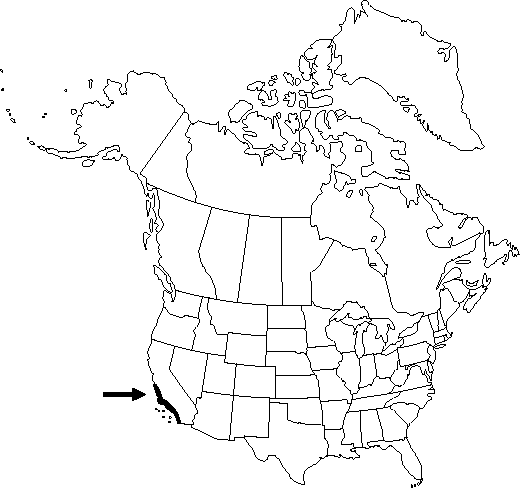Difference between revisions of "Delphinium parryi subsp. maritimum"
Phytologia 68(1): 2. 1990.
FNA>Volume Importer |
FNA>Volume Importer |
||
| Line 20: | Line 20: | ||
}}<!-- | }}<!-- | ||
| − | --><span class="statement" id="st- | + | --><span class="statement" id="st-undefined" data-properties=""><b>Roots </b>less than 10 cm. <b>Stems</b> 15-40 cm. <b>Leaves</b> well distributed; basal and cauline leaves present at anthesis; ultimate lobes 5-10, width usually more than 6 mm. <b>Inflorescences</b>: bracteoles 4-9 mm. <b>Flowers</b>: sepals usually spreading, lateral sepals 9-20 mm, spurs 8-21 mm; lower petal blades 4-11 mm. <b>2n</b> = 16.</span><!-- |
-->{{Treatment/Body | -->{{Treatment/Body | ||
| Line 26: | Line 26: | ||
|habitat=Coastal chaparral | |habitat=Coastal chaparral | ||
|elevation=0-300 m | |elevation=0-300 m | ||
| − | |distribution=Calif.;Mexico (Baja California) | + | |distribution=Calif.;Mexico (Baja California). |
|discussion=<p>Populations of Delphinium parryi subsp. maritimum are local, very near the coast. The species also occurs on islands off southern California and northern Baja California, Mexico. Occasional individuals with white to grayish blue sepals occur (mostly in Ventura and western Los Angeles counties, where entire populations may consist of such individuals). Collections of subsp. maritimum made before 1940 are numerous; recent collections are much less common. Population reductions have probably resulted from urbanization of its preferred habitat.</p><!-- | |discussion=<p>Populations of Delphinium parryi subsp. maritimum are local, very near the coast. The species also occurs on islands off southern California and northern Baja California, Mexico. Occasional individuals with white to grayish blue sepals occur (mostly in Ventura and western Los Angeles counties, where entire populations may consist of such individuals). Collections of subsp. maritimum made before 1940 are numerous; recent collections are much less common. Population reductions have probably resulted from urbanization of its preferred habitat.</p><!-- | ||
--><p>Confused with Delphinium variegatum, D. parryi subsp. maritimum lacks the long hairs of that species. Some plants of subsp. maritimum (unringed seeds, erect fruits, and arched hairs) from very near the coast appear superficially like some plants of D. nuttallianum (ringed seeds, spreading fruits, and no arched hairs).</p> | --><p>Confused with Delphinium variegatum, D. parryi subsp. maritimum lacks the long hairs of that species. Some plants of subsp. maritimum (unringed seeds, erect fruits, and arched hairs) from very near the coast appear superficially like some plants of D. nuttallianum (ringed seeds, spreading fruits, and no arched hairs).</p> | ||
| Line 47: | Line 47: | ||
|habitat=Coastal chaparral | |habitat=Coastal chaparral | ||
|elevation=0-300 m | |elevation=0-300 m | ||
| − | |distribution=Calif.;Mexico (Baja California) | + | |distribution=Calif.;Mexico (Baja California). |
|reference=None | |reference=None | ||
|publication title=Phytologia | |publication title=Phytologia | ||
|publication year=1990 | |publication year=1990 | ||
|special status= | |special status= | ||
| − | |source xml=https://jpend@bitbucket.org/aafc-mbb/fna- | + | |source xml=https://jpend@bitbucket.org/aafc-mbb/fna-data-curation.git/src/9216fc802291cd3df363fd52122300479582ede7/coarse_grained_fna_xml/V3/V3_115.xml |
|genus=Delphinium | |genus=Delphinium | ||
|section=Delphinium sect. Diedropetala | |section=Delphinium sect. Diedropetala | ||
| Line 58: | Line 58: | ||
|species=Delphinium parryi | |species=Delphinium parryi | ||
|subspecies=Delphinium parryi subsp. maritimum | |subspecies=Delphinium parryi subsp. maritimum | ||
| − | |||
| − | |||
| − | |||
| − | |||
| − | |||
| − | |||
| − | |||
| − | |||
| − | |||
| − | |||
| − | |||
}}<!-- | }}<!-- | ||
-->[[Category:Treatment]][[Category:Delphinium parryi]] | -->[[Category:Treatment]][[Category:Delphinium parryi]] | ||
Revision as of 13:32, 27 July 2019
Roots less than 10 cm. Stems 15-40 cm. Leaves well distributed; basal and cauline leaves present at anthesis; ultimate lobes 5-10, width usually more than 6 mm. Inflorescences: bracteoles 4-9 mm. Flowers: sepals usually spreading, lateral sepals 9-20 mm, spurs 8-21 mm; lower petal blades 4-11 mm. 2n = 16.
Phenology: Flowering late winter–spring.
Habitat: Coastal chaparral
Elevation: 0-300 m
Distribution

Calif., Mexico (Baja California).
Discussion
Populations of Delphinium parryi subsp. maritimum are local, very near the coast. The species also occurs on islands off southern California and northern Baja California, Mexico. Occasional individuals with white to grayish blue sepals occur (mostly in Ventura and western Los Angeles counties, where entire populations may consist of such individuals). Collections of subsp. maritimum made before 1940 are numerous; recent collections are much less common. Population reductions have probably resulted from urbanization of its preferred habitat.
Confused with Delphinium variegatum, D. parryi subsp. maritimum lacks the long hairs of that species. Some plants of subsp. maritimum (unringed seeds, erect fruits, and arched hairs) from very near the coast appear superficially like some plants of D. nuttallianum (ringed seeds, spreading fruits, and no arched hairs).
Selected References
None.